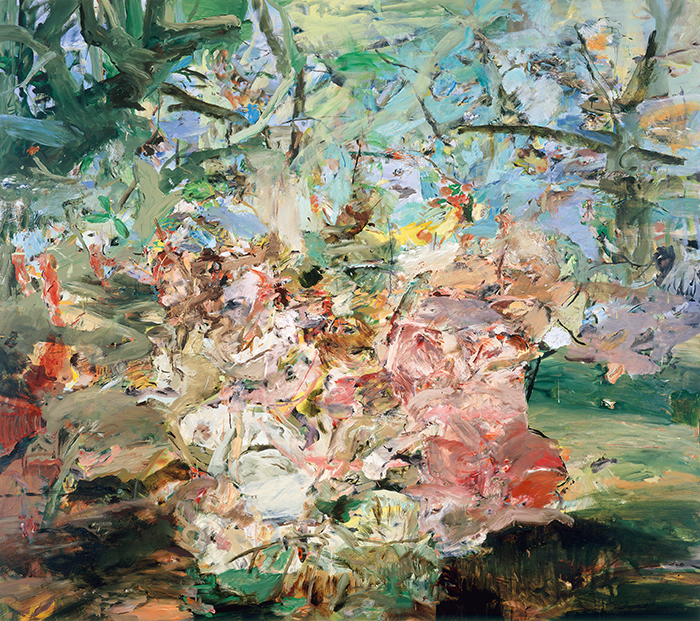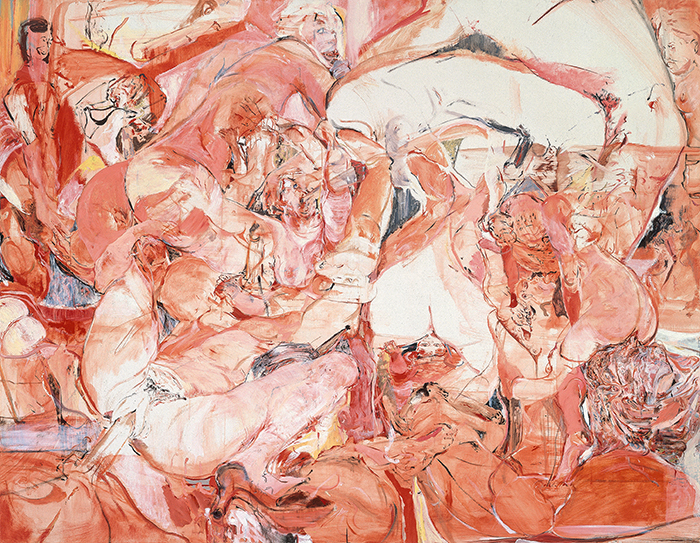When British-born artist Cecily Brown landed in the New York art scene in the mid-1990s, conventional painting had taken a backseat to other less conventional practices of creating art. Conceptual installations and video content, for example, were trending. The transgressive art movement was producing provocative subject matter reflecting angsty societal and global turmoil. For a while, painting almost seemed a little too orthodox for the art capital of the world, though ‘orthodox’ isn’t a word typically associated with Cecily Brown’s works.
Cecily Brown: Themes and Variations, on view at the Dallas Museum of Art through Feb. 9, 2025, explores 33 works by the painter as a mid-career retrospective, ranging from a 1996 work created during her meteoric rise to fame in New York, to a work created as recently as last year. Brodbeck describes Brown’s style as dancing between abstraction and figuration. “Her work is very layered. When you first look at it, there are a lot of abstract elements and layers of paint. But the closer you look at it, there’s always kind of a figure emerging.”
Brown also tends to give wry nods to 17th and 18th century Dutch and Flemish still lifes, noted for portraying sumptuous spreads of food and drink. Other artists of the era would depict spoils of the hunt – carcasses of woodland animals splayed on a table, no doubt awaiting to be defeathered, butchered, or both. Brown, who’s a vegetarian, works this symbolism into Saboteur Four Times, which Brodbeck has chosen as the exhibition’s introductory piece. Three thematic sections follow, beginning with In the Night Garden, comprised primarily of works Brown painted during a time when she was heavily interested in art from the opulent Rococo era. Girl on a Swing references both Francisco de Goya’s The Swing, as well as a painting of the same title by Jean-Honoré Fragonard. What may seem to be playful and flirtatious imagery today was actually brimming with erotic and voyeuristic connotations at the time. “I think she was subtly pointing to how misogynistic most of art history is,” Brodbeck says. “And so, there are several works that both play with this kind of Rococo palette.”

1 ⁄5
Cecily Brown, We didn’t mean to go to sea, 2018, oil on linen, 89 x 83 in., The Rachofsky Collection, © Cecily Brown, photo Genevieve Hanson

2 ⁄5
Cecily Brown, Figures in a Landscape 2, 2002, oil on linen, 80 x 90 in., The Broad Art Foundation, © Cecily Brown, photo Rob McKeever, courtesy Gagosian

3 ⁄5
Cecily Brown, Picture This, 2020, oil on linen, 47 x 43 in., Green Family Art Foundation, Courtesy Adam Green Art Advisory, © Cecily Brown, photo Genevieve Hanson

4 ⁄5
Cecily Brown, On the Town, 1998, oil on linen, 76 x 98 in., The Trustees of the Helios Trust, © Cecily Brown, photo Rob McKeever, courtesy Gagosian

5 ⁄5
Cecily Brown, High Society, 1998, oil on linen, 76 x 98 in., Martin and Toni Sosnoff, © Cecily Brown, photo Rob McKeever, courtesy Gagosian
“She does these deep dives, where she’ll be inspired by something she sees in art history, but it brings to mind something in current events,” Brodbeck says, adding that they’ve created a whole series of Brown’s works based on the motif of shipwrecks within this section. In that same vein, the exhibition includes Brown’s response to the fascination with sirens and nymphs in art history. “Both of them are very sexist tropes,” Brodbeck explains, alluding to the mythological sea goddesses and evil seductresses who would lure sailors to their death. “There are some really wonderful drawings that she did on these two themes.”
—AMY BISHOP





